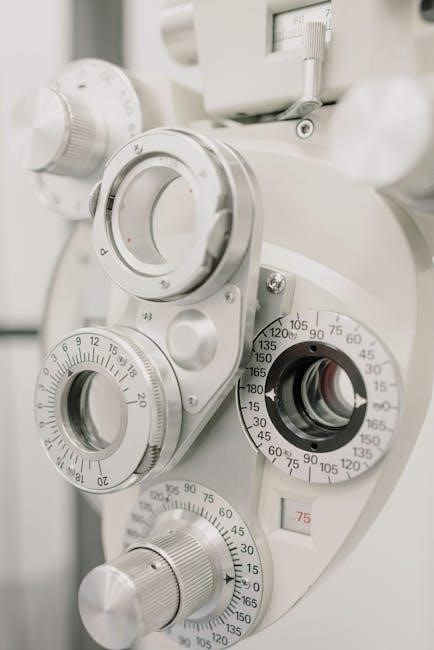thermostatic expansion valve adjustment pdf
A thermostatic expansion valve (TXV) is a critical component in HVAC systems, regulating refrigerant flow․ Proper adjustment ensures optimal superheat, system performance, and energy efficiency․
1․1 Overview of Thermostatic Expansion Valves (TXV)
A thermostatic expansion valve (TXV) is a refrigeration system component that regulates the flow of refrigerant into the evaporator․ It operates by balancing pressure from the refrigerant bulb against the evaporating pressure and spring force․ This balance ensures proper refrigerant injection, maintaining optimal system performance․ The TXV is crucial for controlling superheat, preventing liquid refrigerant floodback, and optimizing energy efficiency․ Its design allows precise adjustment to adapt to varying system conditions, making it essential for HVAC and refrigeration systems․ Proper functionality ensures efficient cooling and prevents potential system damage․
1․2 Importance of Proper Adjustment
Proper adjustment of the thermostatic expansion valve is crucial for optimal system performance and efficiency; Incorrect settings can lead to insufficient cooling, increased energy consumption, and potential system damage․ Correct adjustment ensures proper superheat levels, preventing issues like liquid refrigerant floodback and compressor damage․ It also optimizes energy efficiency and overall system performance․ Regular and accurate adjustment is vital for sustaining the longevity and effectiveness of HVAC and refrigeration systems․
1․3 Safety Precautions Before Adjustment
Before adjusting the TXV, ensure the system is powered off to prevent electrical hazards․ Wear protective gear, including gloves and safety glasses, to protect against refrigerant exposure․ Ensure proper ventilation and avoid inhaling refrigerant gases, as they can be harmful․ Check system pressure and relieve any residual pressure before starting work․ Always follow manufacturer guidelines and safety protocols to minimize risks and ensure a safe working environment during the adjustment process․

Understanding the Components of a TXV
A TXV consists of a bulb, diaphragm, and spring, working together to regulate refrigerant flow․ The bulb senses temperature, while the diaphragm and spring control the valve opening, ensuring proper system operation․
2․1 Key Parts of the Thermostatic Expansion Valve
The TXV comprises essential components, including the bulb, diaphragm, spring, and valve body․ The bulb contains the refrigerant charge, sensing temperature changes․ The diaphragm responds to pressure differences, controlling the valve opening․ The spring provides tension, influencing the valve’s position․ Additional features like an adjustment stem allow for fine-tuning superheat settings․ These parts work harmoniously to regulate refrigerant flow accurately, ensuring efficient system performance and proper superheat levels․
2․2 The Role of the Bulb, Diaphragm, and Spring
The bulb acts as a temperature-sensing element, typically mounted on the evaporator outlet, detecting refrigerant vapor temperature․ The diaphragm responds to pressure differences between the bulb and evaporator, controlling the valve’s opening to regulate refrigerant flow․ The spring applies counter-pressure, influencing the valve’s position․ Together, these components balance system pressures and temperatures, ensuring precise refrigerant injection and optimal superheat levels for efficient operation․ Their coordinated function is vital for maintaining system performance and stability․
2․3 How the Valve Regulates Refrigerant Flow

The thermostatic expansion valve (TXV) regulates refrigerant flow by balancing forces acting on the diaphragm․ The bulb senses vapor temperature, creating pressure that pushes the diaphragm downward․ Simultaneously, spring tension and evaporator pressure act to close the valve․ As the bulb pressure increases, the valve opens wider, allowing more refrigerant to flow․ This dynamic equilibrium ensures the correct amount of refrigerant enters the evaporator, maintaining optimal superheat and system efficiency․ Proper adjustment of the spring tension fine-tunes this balance for precise control․

Tools and Equipment Needed for Adjustment
Essential tools include a screwdriver, pressure gauge, thermometer, and manifold set․ Safety gear like gloves and goggles is crucial․ Ensure all equipment is calibrated for accuracy․
3․1 Essential Tools for TXV Adjustment
Adjusting a TXV requires specific tools, including a manifold gauge set, screwdrivers, and a thermometer․ A pressure gauge measures refrigerant pressure, while a vacuum pump ensures system readiness․ Additional tools like wrenches and Allen keys may be needed for accessing the valve․ A superheat calculator or chart is also essential for precise adjustments․ Always ensure tools are compatible with the valve type and refrigerant used․ Proper equipment ensures accurate and safe adjustments, preventing system damage or inefficient operation․
3․2 Measuring Instruments for Superheat and Pressure
Accurate measurement is crucial for TXV adjustment․ A digital manifold gauge measures high and low refrigerant pressures, while a vacuum gauge ensures system evacuation․ Thermometers or temperature sensors measure evaporator inlet and outlet temperatures to calculate superheat․ Pressure clamps or ports allow connection to the system․ Using these tools, technicians can determine if superheat levels are within the recommended range, typically between 8-12°F, ensuring optimal valve performance and system efficiency without risking damage from improper settings․
3․3 Safety Gear and Protective Equipment
Adjusting a TXV requires proper safety gear to prevent injury․ Wear insulated gloves, safety goggles, and a face mask to protect against refrigerant exposure and system debris; Ensure the work area is well-ventilated to avoid inhaling refrigerant fumes․ Use a refrigerant leak detector to identify potential gas leaks․ A pressure-testing kit is essential for verifying system integrity before and after adjustments․ Always follow manufacturer guidelines and safety protocols to avoid accidents and ensure a safe working environment during the adjustment process․

Step-by-Step Adjustment Process
Adjusting a TXV involves preparing the system, locating the valve, setting initial parameters, turning the adjustment screw, and testing superheat levels to ensure optimal performance following manufacturer guidelines․
4․1 Preparing the System for Adjustment
Before adjusting the TXV, ensure the system operates under normal conditions․ Check refrigerant levels, ensure proper pressure, and verify evaporator and condenser functions․ Turn off the system, allowing it to stabilize․ Safety precautions include wearing protective gear and ensuring no refrigerant leaks․ Measure superheat at the evaporator outlet to establish a baseline․ Record initial settings for comparison post-adjustment․ Proper preparation ensures accurate adjustment and avoids system imbalance or damage․
4․2 Locating the Thermostatic Expansion Valve
The thermostatic expansion valve (TXV) is typically installed between the condenser and evaporator coils․ It is usually mounted near the evaporator inlet to regulate refrigerant flow effectively․ Look for a small, brass or stainless steel valve with a bulb-like sensor attached to the evaporator coil․ The TXV may also be labeled or color-coded for easy identification․ Ensure the system is turned off before attempting to locate or adjust the valve, as this ensures safety and prevents accidental system activation during the process․
4․3 Initial Setup and Calibration
Before adjusting the TXV, ensure the HVAC system is operating under stable conditions․ Check for any leaks or blockages in the refrigerant lines․ Allow the system to run for 10-15 minutes to achieve equilibrium․ Connect manifold gauges to the low- and high-pressure ports to monitor system pressures․ Set the desired superheat based on the manufacturer’s specifications or the system’s requirements․ Use the adjustment screw to fine-tune the valve, ensuring minimal changes to avoid system instability․ Record initial readings for reference during the adjustment process․
4․4 Turning the Adjustment Screw
Locate the adjustment screw on the TXV, typically a stem with a knob or Allen wrench fitting․ Turning the screw clockwise increases the superheat by reducing refrigerant flow, while counterclockwise decreases superheat․ Make small, incremental adjustments, allowing the system to stabilize before further changes․ Monitor system performance and pressure readings to ensure the desired superheat is achieved without over-correction․ Avoid over-tightening, as this can restrict refrigerant flow excessively, leading to reduced system efficiency or potential damage to components․
4․5 Testing and Verifying the Adjustment
After adjusting the screw, monitor the system’s performance to ensure proper operation․ Measure the superheat using a manifold gauge set to confirm it aligns with the manufacturer’s recommended range․ Check both high and low-side pressures to verify system balance․ Observe the evaporator’s performance, ensuring no frosting or reduced airflow․ Allow the system to run for several minutes to stabilize before finalizing the adjustment․ Record the settings and pressures for future reference and to ensure consistency in system operation․

Understanding Superheat and Its Adjustment
Superheat is the difference between refrigerant temperature and its saturation temperature at a given pressure․ Proper adjustment ensures optimal performance and prevents system damage․
5․1 What is Superheat and Why is it Important?
Superheat is the temperature difference between refrigerant vapor and its saturation temperature at a given pressure․ It ensures the evaporator operates efficiently without liquid refrigerant flooding the compressor, preventing damage․ Proper superheat levels maintain system performance, efficiency, and longevity․ Adjusting the TXV regulates superheat, ensuring optimal refrigerant flow and system reliability․ Incorrect superheat can lead to reduced cooling capacity or compressor failure, making precise adjustment critical for HVAC systems․
5․2 How to Measure Superheat
Measuring superheat involves using a digital manifold gauge or thermistor to monitor the evaporator’s inlet pressure and temperature․ Subtract the saturation temperature from the evaporator’s outlet temperature to determine superheat․ Ensure the system operates under steady conditions to obtain accurate readings․ Proper measurement tools and techniques are essential for precise TXV adjustment, ensuring optimal system performance and preventing potential damage from incorrect settings․ Always refer to the manufacturer’s guidelines for specific measurement procedures and superheat ranges․
5․3 Adjusting the TXV for Optimal Superheat
Adjust the TXV by turning the adjustment screw clockwise to increase superheat or counterclockwise to decrease it․ Make small increments, allowing the system to stabilize before rechecking․ Ensure the superheat aligns with the manufacturer’s recommended range, typically between 8-12°F for most systems․ Proper adjustment ensures efficient refrigerant flow and prevents system damage․ Always follow the manufacturer’s specific instructions for your TXV model and monitor performance after adjustments to maintain optimal operation․

Troubleshooting Common Issues
Identify symptoms like incorrect superheat, refrigerant flow issues, or system performance problems․ Diagnose root causes, such as improper adjustment or valve malfunction, to resolve efficiently․
6․1 Symptoms of Incorrect Superheat
Incorrect superheat can lead to reduced cooling performance, ice buildup on the evaporator, or increased energy consumption․ High superheat may cause reduced refrigerant flow, while low superheat can flood the compressor․ Symptoms include inconsistent system operation, higher utility bills, and potential equipment damage․ Addressing these issues promptly ensures optimal system efficiency and longevity․ Regular monitoring and adjustment are crucial to maintain proper superheat levels and prevent such problems․ Always refer to manufacturer guidelines for specific troubleshooting steps and solutions․
6․2 Diagnosing Refrigerant Flow Problems
Diagnosing refrigerant flow issues begins with checking superheat levels․ Low superheat may indicate excessive refrigerant flow, risking evaporator flooding․ High superheat suggests insufficient flow, reducing system performance․ Ice buildup on evaporator coils can signal low superheat․ Use a manifold gauge set to measure pressure and temperature, identifying restrictions or blockages․ Inspect the filter-drier for blockages and ensure the TXV adjustment is correct․ Verify the bulb placement and connections for accurate temperature sensing․ Check the condenser’s condition, as poor performance can affect system pressure․ Address any found issues promptly to restore proper flow and efficiency․
6․3 Common Mistakes During Adjustment
Common mistakes during TXV adjustment include over-tightening the adjustment screw, which can damage the valve․ Another error is turning the screw too quickly without allowing the system to stabilize․ Neglecting to recheck superheat after adjustments is also frequent․ Overlooking proper safety precautions, such as wearing protective gear, can lead to accidents․ Additionally, incorrect use of tools or failing to follow manufacturer guidelines can result in improper adjustment․ Always refer to the valve’s manual and ensure system stability before finalizing changes․

Maintenance and Follow-Up
Regular maintenance ensures the TXV operates efficiently․ Schedule periodic inspections and cleanings to prevent debris buildup․ Keep records of adjustments for future reference and system optimization․
7․1 Regular Maintenance for TXV
Regular maintenance is essential to ensure the TXV operates efficiently․ Inspect the valve for blockages and clean it as needed․ Check the filter-drier and replace it if contaminated․ Ensure the evaporator coil is clean to maintain proper airflow․ Verify that the bulb is correctly mounted and insulated․ Monitor system pressures and superheat levels regularly․ Schedule annual professional inspections to address any potential issues before they escalate․ Proper maintenance extends the lifespan of the TXV and ensures consistent system performance․
7․2 When to Re-Adjust the TXV
Re-adjust the TXV when system performance issues arise or after significant changes․ If superheat levels deviate from the recommended range, adjustment is necessary․ Changes in ambient temperature or load conditions may also require re-calibration․ After replacing components like the filter-drier or evaporator coil, re-adjustment ensures optimal flow․ Additionally, if refrigerant pressure or flow imbalances are detected, the TXV should be fine-tuned․ Regular monitoring helps identify when re-adjustment is needed to maintain efficiency and prevent system damage;
7․3 Documenting Adjustment Results
Documenting TXV adjustment results ensures accountability and provides a reference for future maintenance․ Record the initial and final superheat settings, along with any changes made to the adjustment screw․ Note the system’s operating conditions, such as pressure and temperature, before and after adjustment․ Include the date, technician’s name, and any specific issues resolved․ Proper documentation helps verify compliance with manufacturer guidelines and simplifies future troubleshooting․ Store records in a centralized system for easy access and long-term tracking of system performance․
Proper TXV adjustment is vital for system efficiency․ Always follow manufacturer guidelines and document results․ Regular maintenance ensures optimal performance and extends equipment lifespan․
8․1 Summary of Key Points
Adjusting a thermostatic expansion valve (TXV) involves understanding its role in regulating refrigerant flow and superheat․ Superheat is the temperature difference between the refrigerant vapor and its saturation point․ Turning the adjustment screw clockwise increases superheat, while counterclockwise decreases it․ Proper adjustment ensures efficient system operation, prevents compressor flooding, and maintains optimal cooling․ Using a manifold gauge set to measure pressure and calculate superheat is essential; The ideal superheat range is typically between 8 to 12 degrees Fahrenheit․ Safety precautions, correct tools, and adherence to manufacturer guidelines are crucial․ Regular documentation of adjustments aids in future maintenance and performance tracking․
8․2 Best Practices for Future Adjustments
When performing future TXV adjustments, always refer to the manufacturer’s guidelines and use calibrated tools like manifold gauge sets and vacuum pumps․ Ensure the system operates under stable conditions before making adjustments․ Wear protective gear, including gloves and safety glasses, to prevent accidents․ Document all adjustments for future reference and to track system performance over time․ Regularly inspect the valve and surrounding components for signs of wear or damage․ Testing the system thoroughly after adjustments ensures optimal performance and prevents potential issues․ Consistent documentation also aids in complying with maintenance schedules and industry standards․
8․3 Additional Resources for Further Learning
For deeper understanding, consult manufacturer manuals like Emerson’s TXV Superheat Adjustment Chart and Danfoss guides․ Online forums and tutorials, such as those by Sporlan, offer practical insights․ Academic papers on TXV operation and adjustment are also valuable․ YouTube tutorials provide visual guidance, while industry workshops can enhance hands-on skills․ Always refer to updated resources to stay current with advancements in HVAC technology and best practices for TXV adjustment and maintenance․


